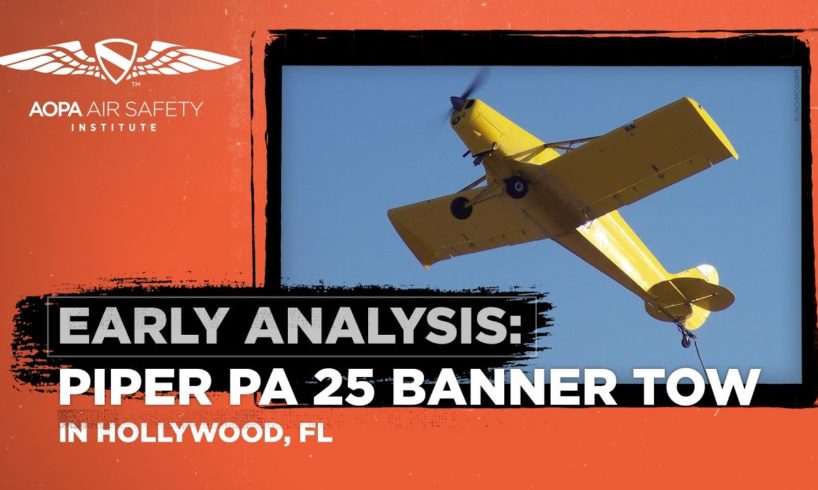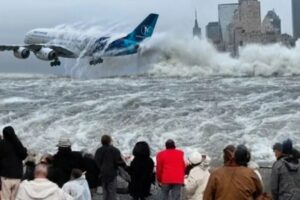
The AOPA Air Safety Institute (ASI) makes a preliminary assessment of the accident that occurred on May 17th, 2023, involving a Piper PA-25 Pawnee banner tow aircraft. The aircraft impacted North Park Road in Hollywood, Florida. Tragically, the single occupant was killed.
Sources:
LiveATC.net https://www.liveatc.net/
FlightAware https://flightaware.com/
Zachary Lewis https://www.youtube.com/@zacharylewis5268
WKMG News 6 ClickOrlando https://www.youtube.com/@News6WKMG
The Aircraft Owners and Pilots Association (AOPA) is the largest community of pilots in the world, providing aviation advocacy, education & inspiration. AOPA has represented the freedom to fly for all pilots since 1939. To learn more about becoming a member visit https://www.aopa.org/jointoday.
Check out the Air Safety Institute Website:
https://www.aopa.org/training-and-safety/air-safety-institute
Follow AOPA on Twitter:
Tweets by flywithaopa
Follow AOPA on Instagram:
https://www.instagram.com/flywithaopa/
Follow AOPA on Facebook:
https://www.facebook.com/flywithaopa
#aopa #flywithaopa #aviation #pilot #flying
source







I miss the old case study style videos.
2:02 Respect door banner towers, that dive to pick up the cable. 8:37
The banner is way too big, they used to be one third that big,the rope is also too long,and that plane is underpowered.This gal should check out some old film ,she does not get it.
Drones should be dragging these banners. Or else they shouldn't be risking young aviators lives just because they're cheap labor.
I lived in Miami for 10 years and can remember precisely zero of the many banners I saw. They are not an effective advertising tool and haven't been since the 1940s.
8:10 what the heck? Odd focus issues(?) in this footage. Using the frame fwd/back keys, I'm still mystified.
A have towed for several years and one time I could not hold 1,000 feet and ended up at 500 feet just. Cause DOWN DRAFT which nobody seem to mention.
Nothing wrong with my engine at the time.
I made use of flaps to ride the stall/sink and was able to fly out of it.
I’m a banner tower, he should have dropped the nose prior to dropping banner, really sad his bucket of experience was so low.
It looks to me like he either didn't pick up the banner at a high enough speed to get real laminar airflow over the wings or once he did he didn't think he could dive a bit to get his airspeed up to get that flow.
I'm not a flyer but I'm a sailor and I know sometimes you have to point downwind a bit to pick up your speed to get that wing/sail out of the edge of a stall then once you've done that you can then turn around and point a lot higher than before with no problem
At around 12:00 she contradicts herself. She talks about the planes needing "reserve power" but then she says that when banner pulling the planes are at or near full power the whole time. If it's the latter situation, that sounds ridiculously dangerous/foolish. It sounds like they're just trying to save money by not having planes that are up to pulling banners that large. Engineers usually build in at least a double or triple safety margin for the rating, so these planes should either double their power output or only pull banners that are half that size/weight.
This almost sounds like another Titan submersible fiasco
Very sad. Wouldn't want to be in his seat.
Here is an unrelated to the actual incident question: Has anyone bought any product or service or were influenced in any way, even microscopically, by seeing a banner towed by a plane?
Are products flying off the shelf, are the phones for services ringing off the hook?
Flying is risky enough as it is, why add nonsense to the equation?
Not a pilot but I am going to say new pilots should NOT be doing those kinds of flights. Now way to have the response and correct inputs under stress with such low experience. Terrible way for a freshly minted pilot to gain hours.
Nice landing.
I know the pilot , he is very very nice guy, he live my house about 8 months, he is best guys I have ever see, why god like take good people.
The banner can actually help the plane fly below published stall speed. It can act like the tail streamer on a kite that stabilizes the plane to help it fly straight. Dropping the banner may have actually done more harm than good, as evidence d in the video. As soon as the banner departs, roll control is lost.
I ve had several incidents towing banners in multiple aircraft types as wel as trained several new pilots. Unfortunately most training places emphasis on pick up and dropping procedures. In my training we allocated significant time to stall spin recovery proficiency and unbalanced slow flight manoeuvres – energy management, situational awareness. Banners should never be flown over any area where they cannot be dropped at any time. When towing a banner the rudder pressures can be high to get close to balanced flight. Think asymmetric flight in a twin for example. In un balanced flight the ASI is not and accurate instrument thus a small margin above stall speed is a really bad choice. When you drop the banner with full power applied the aircraft accelerates rapidly – feels like letting foot off brakes, if back pressure maintained thus nose allowed to rise too quickly with high rudder pressure maintained by mistake a stall spin departure from controlled flight is likely. This is what this accident looks like to me.
Inexperience was the key problem that caused this accident. I have towed banners for many years and while there is a lot going on right after you pick the banner, flying the plane at the correct speed is key. The pilot held the nose too high which kept the plane in a stall. Because he was constantly in a stall, he was unable to gain any altitude. When the pilot realized he was not climbing, he should have remained or returned to the banner area, and dropped the banner if need be. The tower routinely allows you to climb in the ‘banner box’ pattern with no disruption to other air traffic at the airport. When the pilot finally did release the banner while the airplane was stalled, the release of energy and his foot on the rudder put the airplane into a spin. At 400 ft, there was insufficient altitude to recover. It is easy to blame it on pilot error. In reality banner flying is complicated and difficult. There was no engine trouble. The pilot had a semi-heavy banner and he did not realize that the climbing process is sometimes very slow. Trying to force the nose of the plane up has a detrimental climbing effect as the plane flounders in and out of a stall. Incredibly sad for everyone involved with this accident.
I wonder if he had a incorrect trim setting that caused his to fly at a high angle of attack.
So informative. Awesome content. Happened in my neighborhood. Answered so many questions. God bless this pilot. My condolences to the aviation community. Thanks again.
Only problem with the video is the clips of banner towing from Zachary Lewis showcases tremendously risky and unnecessarily dangerous pickup techniques. Industry standard is a gentle low approach followed by around a 30 degree nose up climb. Diving down towards the banner and then aggressively pulling up like that is a way to mush into the ground while still missing banner pickups regularly.
Excellent explanation of the process.
Too heavy a banner?
I was his commercial instructor. I begged him not to go to Florida to do banner towing. He was the best student I ever worked with…
..hmm i used to be a photographer and most people's "good side" is their left side, so i always pay attention to how the interview is set up.
-you can always tell the vain person, sometimes subconsciously lol. 🙄
RIP pilot, condolences to the family and all who feel this loss. This being said, I've never looked up at a banner and thought "oh wow, let me call that company or look up that company, I'm so glad I saw this ad" especially in a casual or vacation moment by the beach or at a sporting event where these banner plans typically fly. With all due respect to those who opt in to fly these planes, in my humble opinion, this has to be one of the stupidest forms of advertising where the engagement / response rate is so low that all these planes do is create noise pollution and an intrusive distraction to those enjoying a beautiful day. Do we really need advertising everywhere we go? On top of that, being that there is an inherent risk involved, it seems to be a senseless and deliberate loss of life when this practice has the potential to end in tragedy. Personal opinion, FAA needs to put an end to this.
Tons of insight from Alicia. I learned a lot listening to her share her experience, great job.
I learned to fly at Lakewood, NJ (N12) & it is the banner plane hub around here (Jersey Shore) in the summer of 1995 in C152's. One day my instructor said "want to go check out one of the banner planes (that was parked on the other side of the runway)? So we taxiied over to the banner plane side of the field & shut down and then we walked on over & I got to check out the plane. What a dump. It made the inside of the C152 look like a Cirrus SR22. Crappy, beat down, no doors, Doritos wrapperes and Coke cans flopped around, pencil writing on the dash & graffiti. I was stunned as I've seen these planes non stop in the summer over my house & at the beach and had no idea how rickety they were. I remember looking at the inside thinking that there is no way in hell I would fly one of those.
Thank you Alicia for bringing us into a world of flying that even flight nerds know jack about. So many questions after watching this detailed analysis… Why don't we use unmanned air vehicles to put adverts in the sky? This banner flying "tech" is kind of obsolete and dangerous, no? No pilot should have to deal with this crap. 5 knots above stall speed, pulling a drag inducing wind vane is the norm… sounds like mission impossible. wtf… somebody make it make sense. How can we do this safer using the tools available? Why put inexperienced pilots on this complex mission? Is the pay rate low or high? Good job shedding this light. Hopefully this incident will incentivise safety improvements here.
Prehistoric type of Advertising 🤷🏾♂️🤷🏾♂️🤷🏾♂️. RIP to the pilot.
Thank you for this video, you both hit all points for clarification and learning. Very sad story my condolences to the family 🙁
This sounds like such a dangerous yet unnecessary activity. Shouldn't this banner towing stuff ultimately be banned?
The video of the crash says it all. Just before banner release, the plane's wings are rocking, consistent with the plane operating just above its stall speed. Notice that at the instant the banner is released, the plane yaws sharply RIGHT, and then the right wing drops. This may be explained like this: the banner — with its considerable drag — acts as a powerful "yaw damper", keeping the nose straight by largely over-riding any actual rudder forces.
When the banner is released, that damping force is instantly gone, allowing any rudder input to suddenly affect the aircraft. In this case — and at the edge of the stall — existing right rudder input would cause a sudden right yaw with immediate right wing stall as seen in the video.
This accident is tragic, especially since it may have been prevented with proper training for this novice banner pilot. An emergency banner drop is not the same as a routine one, and this might represent a gap in typical banner ops training. RIP; he tried so hard to do the right thing and protect innocent lives.